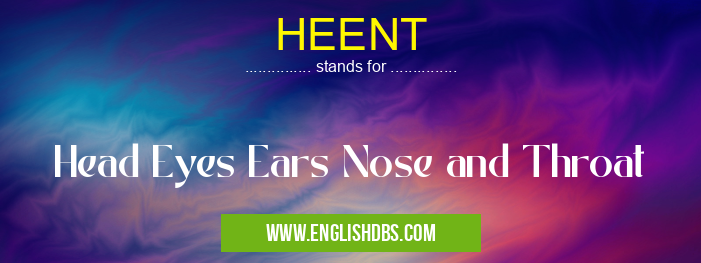What does HEENT mean in UNCLASSIFIED
In the medical field, HEENT is a commonly used abbreviation that stands for Head, Eyes, Ears, Nose, and Throat. It represents the anatomical regions of the human body that are collectively examined and assessed during a comprehensive medical evaluation known as a HEENT examination.

HEENT meaning in Unclassified in Miscellaneous
HEENT mostly used in an acronym Unclassified in Category Miscellaneous that means Head Eyes Ears Nose and Throat
Shorthand: HEENT,
Full Form: Head Eyes Ears Nose and Throat
For more information of "Head Eyes Ears Nose and Throat", see the section below.
HEENT Components
- Head: The head includes the scalp, skull, and facial structures.
- Eyes: The eyes include the eyelids, eyelashes, eyebrows, conjunctiva, cornea, iris, pupil, lens, retina, and optic nerve.
- Ears: The ears consist of the outer ear (pinna), middle ear (eardrum, ossicles), and inner ear (cochlea, vestibular apparatus).
- Nose: The nose comprises the external nose, nasal cavity, and paranasal sinuses.
- Throat: The throat encompasses the oropharynx (back of the mouth), nasopharynx (upper throat), and hypopharynx (lower throat).
HEENT Examination
A HEENT examination involves a thorough physical examination of the head, eyes, ears, nose, and throat. The examiner uses a variety of techniques, including visual inspection, palpation, and auscultation, to assess the following:
- Skull shape and integrity
- Facial symmetry and mobility
- Eye movement, vision, and pupillary reflexes
- Ear shape, hearing, and balance
- Nasal septum, turbinates, and sinuses
- Oral cavity, tongue, and tonsils
- Pharynx and larynx
Essential Questions and Answers on Head Eyes Ears Nose and Throat in "MISCELLANEOUS»UNFILED"
What is included in the HEENT exam?
The HEENT exam is a physical examination of the head, eyes, ears, nose, and throat. It is typically performed as part of a routine physical examination or when a patient presents with symptoms related to these areas. The HEENT exam can help identify a wide range of conditions, including infections, injuries, and tumors.
What does the HEENT exam involve?
The HEENT exam typically involves a visual inspection of the head, eyes, ears, nose, and throat, as well as palpation (feeling) of these areas. The examiner may also use a lighted instrument called an otoscope to examine the ears, and a nasal speculum to examine the nose.
What are some of the conditions that can be identified by the HEENT exam?
The HEENT exam can help identify a wide range of conditions, including:
- Infections, such as sinusitis, otitis media, and tonsillitis
- Injuries, such as lacerations, fractures, and concussions
- Tumors, such as skin cancer, oral cancer, and nasopharyngeal cancer
- Neurological disorders, such as Bell's palsy and trigeminal neuralgia
- Endocrine disorders, such as thyroid disease and Cushing's syndrome
How often should I get a HEENT exam?
The frequency of HEENT exams varies depending on the individual's age, health status, and risk factors. Generally, it is recommended to get a HEENT exam at least once a year as part of a routine physical examination.
What should I do if I have any concerns about my head, eyes, ears, nose, or throat?
If you have any concerns about your head, eyes, ears, nose, or throat, it is important to see your doctor right away. Early diagnosis and treatment of HEENT conditions can help improve outcomes and prevent complications.
Final Words: The HEENT abbreviation serves as a comprehensive term that encompasses the anatomical regions of the head, eyes, ears, nose, and throat. A thorough HEENT examination is an essential component of a complete medical assessment, providing valuable information about the health and well-being of these important body structures. By understanding the significance and components of HEENT, healthcare professionals and patients can effectively communicate about the evaluation and management of head and neck conditions.
